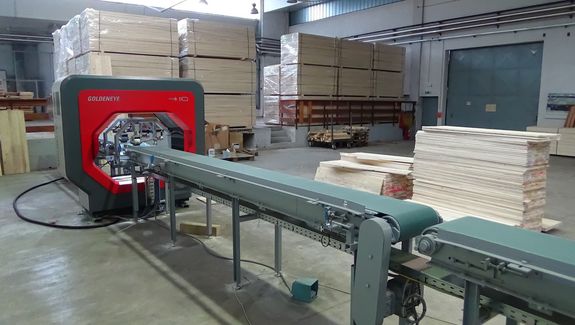If you want to repair defects in formwork panels, you need a good eye and a quick hand. At points where a piece of the knot has come away from the board and could leave behind a hole, the panel needs to be drilled and the area filled with undamaged wood. This task is mentally and mechanically demanding, but even something as complex as this can now be taken care of by robots. A research team from TU Wien (Matthias Hofmair, Martin Melik-Merkumians, Martin Böck and Johannes Zajc from teams led by Prof. Andreas Kugi and Prof. George Schitter) has worked with partners from science and industry to develop a fully automatic method of processing wooden panels.
A high-tech industry
"At first glance, you might think that the wood processing industry is a low-tech one, but you'd be wrong" says Prof. Andreas Kugi from the Institute of Automation and Control (ACIN). "Even industries in which automation is sometimes not as far advanced can benefit hugely from control systems and robots."
Knots are a problem in wood processing, as a knot that isn't fully bonded with the rest of the board could fall out of a formwork panel, such as those used in concrete construction. Repairing these points is a laborious task that is currently completed by hand. However, an automatic process has now been developed that has already proven effective: There is already prototype equipment successfully running in a sawmill owned by the project partner Lip Opazne Plosce Bohinj in Bohinjska Bistrica, Slovenia, correcting defects in wood, which would otherwise be done manually. The equipment identifies damaged areas in the wood and assesses whether they are acceptable or need to be repaired, and it does this better than a person can. Plus, when it comes to the speed and precision with which the machine carries out the required repairs, it is superior to anything a person could do.
Saving time and valuable resources
"Wood is a valuable raw material," says Andreas Kugi. "The aim of the project was to maximise the machine's throughput, thereby making optimum use of the wood. With the help of intelligent machines, we can minimise scrap and prevent wastage."
The formwork panel is first scanned using a camera network. This detects problem points, decides which need to be removed and calculates the minimum number of patches required. "A person would rely on their gut instinct here and would probably drill more holes than was necessary," says Kugi. The robot removes circular pieces from the board and replaces them with a 'patch', a piece of a similar size from a knot-free batten.
The order in which the work is completed also affects how long it takes. The patch robot has to be directed over the surface of the board so that it can access all of the problem points in as short a time as possible – a task that is known as the 'travelling salesman problem'.
"From the perspective of control and feedback control systems, this project posed several technically challenging questions," says Andreas Kugi. The movements of the formwork panels and the robot need to be as quick as possible, while still being precise to the millimetre. If the board is moved using rubber-coated chains, this results in slippage between the chains and the formwork panel, meaning that the board doesn't end up exactly in the previously calculated position. The robot therefore has to visually monitor the position of the board and automatically adjust the planned procedure to any changes that may occur.
Individual processing: the future of industrial production
"Previously, automation meant a larger number of pieces being processed by a machine in exactly the same way. That would be completely impossible here because each piece of wood is unique and has to be processed in a different way," says Andreas Kugi. "This project shows where the future of automation technology lies – in automatic, but customised, highly flexible processing."
This has been made possible by the interaction of several areas of research: modern communication and information technology, sensor technology, image processing, mechatronics, system theory and control systems. Andreas Kugi believes that customised automation technology that can also be used efficiently for small production series or even to make individual pieces will result in long-term changes to the economy and the working world: "By making intelligent use of automation and robots, we can stop the manufacturing exodus from high-wage countries such as Austria and create new, high-quality jobs."
The research that produced these results was supported by the European Union 7th Framework Programme (FP7/2007–2013): EU FP 7 project: Holonic Integration of Cognition, Communication and Control for a Wood Patching Robot (HOL-I-Wood PR, project number 284573). For this project, TU Wien worked with MiCROTEC, TTTech Computertechnik AG, Springer Maschinenfabrik and LIP OPAZNE PLOSCE BOHINJ as well as the research partners TU München and Lulea University of Technology.
Wood patching robot
Robots identify material defects and repair them: TU Wien's automation technology makes wood processing more efficient and uses fewer resources.
![[Translate to English:]](/fileadmin/_processed_/d/5/csm_HolzPatch03_95c3f300f1.jpg)
© TU Wien
1 of 3 images or videos
[Translate to English:]
[Translate to English:]

© TU Wien
1 of 3 images or videos
![[Translate to English:]](/fileadmin/_processed_/0/9/csm_HolzPatch04_1f4cc8b78f.jpg)
© TU Wien
1 of 3 images or videos
[Translate to English:]
[Translate to English:]